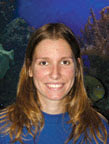
That Fish Blog is proud to introduce our first guest blogger; Melissa Leiter. Melissa is one of our staff Marine Biologists, as well as being an avid aquarium hobbyist. Melissa is also a Fish Room Supervisor in our Lancaster, PA retail store.
Welcome Melissa.
If you are looking for a one of a kind vacation and are scuba certified, Roatan, Honduras is a place you really should consider. I had the opportunity to take a summer class offered through Millersville University in Roatan, Honduras. It was a very intense 3 week class but I learned so much and had a blast all at the same time. It was really nice to be able to see many of the fish that we sell at That Fish Place in their natural environment swimming around so gracefully.
The corals themselves were an amazing sight to see. The reef structure in itself was more than I could have ever imagined. We did many dives to observe the reef, paying close attention to detail so that we would be able to identify a variety of corals learning their common name as well as scientific name.
We had the opportunity to do two night dives to observe the night life on the reef. We descended into the warm darkness right around sunset. The reef is a totally different world when surrounded by darkness. Stoplight parrotfish, Sparisoma viride could be seen in a mucous cocoon and most of the fish that were out and about during the day were totally out of sight, hidden in crevices for protection from the creatures that roam in the night. Octopus and cuttlefish were out scouring for food as well as large spiny lobsters and spider crabs. Basket stars, Astrophyton muricatum, were also abundant with their arms outstretched collecting plankton as it drifted by. At random times throughout our night dives we took a few minutes to “feed the corals” where we held our dive lights to a coral and all the plankton swarmed to the light and became coral food. The pillar coral, Dendrogyra cylindrus was a favorite to feed with its polyps extending and retracting continuously.
One of the last things we did before our ascent to the surface was to gather together on the sandy bottom and turned out our lights for a few minutes. Once our eyes adjusted to the darkness the bioluminescence came into view. If you waved your arms that was enough to agitate the critters that store the bioluminescence and you could see a faint light coming out of the pitch black . Another spectacular sight were “string of pearls”. “String of pearls” are ostracods, which are tiny crustaceans that are scurrying about. These tiny crustations attract mates along the same lines as fireflies do flashing their bioluminenscence, each species with a slightly different pattern. They lit up the dark with flashes of light all strung together like fireflies dancing through the sky.
While my diving at the reef has come to an end for this trip the memories I have gathered will remain with me for many years to come. Maybe if more people we able to see the reef first hand they would want to do all they could to save it for future generations. The ocean truly is a world of its own.
~Melissa
 That Fish Blog – Aquarium Advice and Information
That Fish Blog – Aquarium Advice and Information
